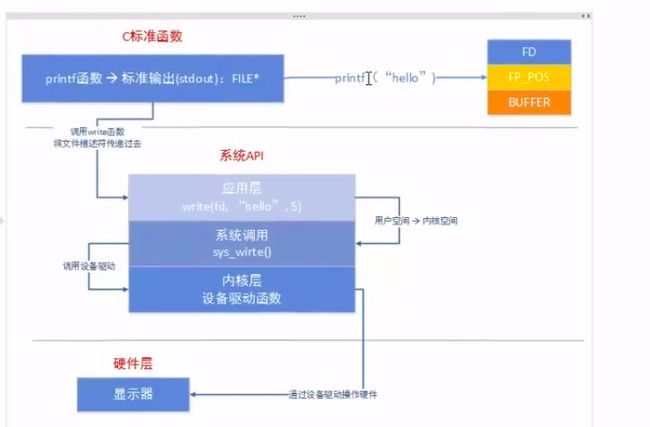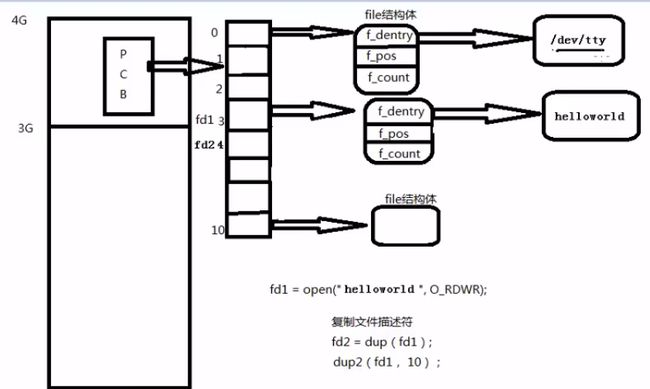Linux系统函数之IO函数
技术交流 QQ 群:1027579432,欢迎你的加入!
欢迎关注我的微信公众号:CurryCoder的程序人生
1.标准C库IO函数工作流程
- IO缓冲区的作用?
- 大部分硬盘都是机械硬盘,读取寻道时间和写入寻道时间都是在毫秒级ms;
- 相对来说,内存读写速度都非常块,因为内存属于电子设备,读写速度是纳秒级ns;
- 两者之间的读写速度相差一百万倍;
2.标准C库函数与Linux系统函数之间的关系
3.虚拟地址空间
- 程序运行以后,首先,每个进程都会创建各自独立的虚拟地址空间。接着,CPU执行代码时(实质是CPU中的MMU将虚拟地址空间中的数据映射到物理内存中,然后在物理内存中进行数据处理),其实是在物理内存中进行数据处理的。
- 虚拟地址空间的优点:在虚拟地址空间中的堆空间中申请了20M堆空间。为了能在物理内存中进行数据处理,需要将虚拟地址空间中的数据映射到物理内存中。但是,物理内存中没有连续的20M内存空间。然而,使用了这种映射机制后,可以将物理内存中不连续的20M内存空间连接到一起。例如:C++的STL中的vector内存地址是连续的,但是deque的内存地址是不连续的,却可以通过映射机制能够保证内存地址是连续的。
4.文件描述符表
- 标准输入stdin文件描述符0、标准输出stdout文件描述符1、标准错误stderr文件描述符2。
- 文件描述符的作用:通过文件描述符来寻找对应的磁盘文件。
- 进程控制块pcb:本质就是一个结构体。
- 一个进程有一个文件描述符表,前三个默认被占用了。
5.Linux系统文件IO函数
- open函数原型:
- int open(const char *pathname, int flags);
- int open(const char *pathname, int flags, mode_t mode);
- 参数:
- flags参数为一个32位整数:必选参数O_RDONLY, O_WRONLY, O_RDWR
- 可选参数:
- 创建文件:O_CREAT
- 创建文件时检查文件是否存在:O_EXCL
- 如果文件存在,返回-1
- 必选与O_CREAT一起使用
- 追加文件:O_APPEND
- 文件截断:O_TRUNC
- 设置非阻塞:O_NONBLOCK
- 创建文件:O_CREAT
- mode: mode & ~umask(0777 & ~0002)
> Author: CurryCoder
> Mail: 1217096231@qq.com
> Created Time: 2020年07月04日 星期六 21时08分31秒
************************************************************************/
#include -
read函数原型:
- ssize_t read(int fd, void *buf, size_t count);
- 参数:
- fd:open函数的返回值
- buf:缓冲区,存储要读取的数据
- count:缓冲区能存储的最大字节数sizeof(buf)
- 返回值:
- -1:失败
- 成功:
- >0:读出的字节数
- =0:文件读完了
-
write函数原型:
- ssize_t write(int fd, const void *buf, size_t count);
- 参数:
- fd:open函数的返回值
- buf:要写到文件中的数据
- count:strlen(buf)
- 返回值:
- -1:失败
- >0:写入到文件中的字节数
/************************************************************************
> File Name: read_write.c
> Author: CurryCoder
> Mail: [email protected]
> Created Time: 2020年07月04日 星期六 21时34分47秒
************************************************************************/
#include - lseek函数原型:
- off_t lseek(int fd, off_t offset, int whence);
- whence参数:
- SEEK_SET
- SEEK_CUR
- SEEK_END
- 使用:
- a.文件指针移动到头部;
- lseek(fd, 0, SEEK_SET);
- b.获取文件指针当前的位置;
- int len = lseek(fd, 0, SEEK_CUR);
- c.获取文件长度;
- int len = lseek(fd, 0, SEEK_END);
- a.文件指针移动到头部;
- 文件的拓展:
- 文件原大小为100K,现在括扩展为1100K:lseek(fd, 1000, SEEK_END);
- 最后,做一次写操作:write(fd, “a”, 1);
/************************************************************************
> File Name: lessk.c
> Author: CurryCoder
> Mail: [email protected]
> Created Time: 2020年07月05日 星期日 10时40分22秒
************************************************************************/
#include 6.perror和errno
- 全局变量:errno,不同的值,对应不同的错误信息。
- perror():打印错误的函数
/************************************************************************
> File Name: read_write.c
> Author: CurryCoder
> Mail: [email protected]
> Created Time: 2020年07月04日 星期六 21时34分47秒
************************************************************************/
#include 7.阻塞和非阻塞
- 阻塞读终端程序分析:默认bash是前台程序,./a.out启动了一个程序,前台程序变成了./a.out,bash变成了后台程序。./a.out等待用户输入10个字符,实际输入的字符个数>10,剩下的字符还在缓冲区中。read函数解除阻塞,读缓冲区数据,执行write函数,./a.out程序结束执行。bash从后台程序变成了前台程序,然后检查到了缓冲区中剩余的字符,将字符作为shell命令去做解析。
/************************************************************************
> File Name: block_read.c
> Author: CurryCoder
> Mail: [email protected]
> Created Time: 2020年07月05日 星期日 10时56分01秒
************************************************************************/
#include - 非阻塞读终端程序
/************************************************************************
> File Name: unblock_read.c
> Author: CurryCoder
> Mail: [email protected]
> Created Time: 2020年07月05日 星期日 11时15分32秒
************************************************************************/
#include - 阻塞和非阻塞是文件的属性还是系统文件IO函数的属性?答案:文件的属性。
- 普通文件:例如:hello.c默认不阻塞
- 终端设备:/dev/tty,默认阻塞
- 管道/套接字:默认阻塞
8.stat/lstat函数
- stat函数原型:
- int stat(const char *pathname, struct stat *buf);
- struct stat
struct stat {
dev_t st_dev; // 文件的设备编号
ino_t st_ino; // 节点
mode_t st_mode; // 重点:文件的类型和存取的权限
nlink_t st_nlink; // 连接到该文件的硬链接数目,刚建立的文件值为1
uid_t st_uid; // 重点:用户ID
gid_t st_gid; // 重点:用户组ID
dev_t st_rdev; // 设备类型,若此文件为设备文件,则为其设备编号
off_t st_size; // 重点:文件字节数(文件大小)
blksize_t st_blksize; // 块大小(文件系统的I/O缓冲区大小)
blkcnt_t st_blocks; // 块数
struct timespec st_atim; // 最后一次访问时间
struct timespec st_mtim; // 重点:最后一次修改时间
struct timespec st_ctim; // 最后一次改变时间(指属性)
};
- 获取文件大小示例程序:
/************************************************************************
> File Name: stat.c
> Author: CurryCoder
> Mail: [email protected]
> Created Time: 2020年07月05日 星期日 11时48分58秒
************************************************************************/
#include - st_mode[16位整数]
- 0-2bit–其他人权限
- S_IROTH 00004(八进制表示) 读权限
- S_IWOTH 00002 写权限
- S_IXOTH 00001 执行权限
- S_IRWXO 00007 掩码,过滤st_mode中除其他人权限以外的信息
- 3-5bit–所属组权限
- S_IRGRP 00040 读权限
- S_IWGRP 00020 写权限
- S_IXGRP 00010 执行权限
- S_IRWXG 00070 掩码,过滤st_mode中除所属组权限以外的信息
- 6-8bit–文件所有者权限
- S_IRUSR 00400 读权限
- S_IWUSR 00200 写权限
- S_IXUSR 00100 执行权限
- S_IRWXU 00700 掩码,过滤st_mode中除文件所有者权限以外的信息
- 12-15bit–文件类型
- S_IFSOCK 0140000 套接字
- S_IFLNK 0120000 符号链接(软链接)
- S_IFREG 0100000 普通文件
- S_IFBLK 0060000 块设备
- S_IFDIR 0040000 目录
- S_IFCHR 0020000 字符设备
- S_IFIFO 0010000 管道
- S_IFMT 0170000 掩码,过滤st_mode中除文件类型以外的信息
- 0-2bit–其他人权限
/************************************************************************
> File Name: stat.c
> Author: CurryCoder
> Mail: [email protected]
> Created Time: 2020年07月05日 星期日 11时48分58秒
************************************************************************/
#include - lstat函数原型:
- int lstat(const char *pathname, struct stat *buf);
- struct stat
struct stat {
dev_t st_dev; // 文件的设备编号
ino_t st_ino; // 节点
mode_t st_mode; // 重点:文件的类型和存取的权限
nlink_t st_nlink; // 连接到该文件的硬链接数目,刚建立的文件值为1
uid_t st_uid; // 重点:用户ID
gid_t st_gid; // 重点:用户组ID
dev_t st_rdev; // 设备类型,若此文件为设备文件,则为其设备编号
off_t st_size; // 重点:文件字节数(文件大小)
blksize_t st_blksize; // 块大小(文件系统的I/O缓冲区大小)
blkcnt_t st_blocks; // 块数
struct timespec st_atim; // 最后一次访问时间
struct timespec st_mtim; // 重点:最后一次修改时间
struct timespec st_ctim; // 最后一次改变时间(指属性)
};
- stat函数与lstat函数的区别:在于读取软链接文件时不同。
- lstat读取的是链接文件本身的属性
- stat读取的是链接文件指向的文件的属性(追踪、穿透)
/************************************************************************
> File Name: stat.c
> Author: CurryCoder
> Mail: [email protected]
> Created Time: 2020年07月05日 星期日 11时48分58秒
************************************************************************/
#include 9.文件属性相关的函数
- access()试当前用户指定文件是否具有某种属性
- 当前用户:使用哪个用户调用这个函数,这个用户就是当前用户。
- int access(const char *pathname, int mode);
- 参数:
- pathname:文件名
- mode:4种权限
- R_OK 读
- W_OK 写
- X_OK 执行
- F_OK 文件是否存在
- 返回值:
- 0:有某种权限或文件存在
- -1":没有或文件不存在
- 参数:
/************************************************************************
> File Name: access.c
> Author: CurryCoder
> Mail: [email protected]
> Created Time: 2020年07月05日 星期日 15时40分48秒
************************************************************************/
#include -
chmod()修改文件权限
- int chmod(const char *pathname, mode_t mode);
- 参数:
- pathname:文件名
- mode:文件权限,八进制数
-
chown()修改文件所有者和所属组
- int chown(const char *pathname, uid_t owner, gid_t group);
- 参数:
- pathname:文件名
- owner:整型值,用户ID
- 用户ID的查看:/etc/passwd
- group:整型值,用户组ID
- 用户组ID的查看:/etc/group
/************************************************************************
> File Name: chmod.c
> Author: CurryCoder
> Mail: [email protected]
> Created Time: 2020年07月05日 星期日 15时50分54秒
************************************************************************/
#include - truncate()修改文件大小
- int truncate(const char *path, off_t length);
- 参数:
- path:文件名
- length:文件的最终大小
- 比原来小,删除后面的部分
- 比原来大,向后扩展
10.目录属性相关的函数
- rename()文件重命名
- int rename(const char *oldpath, const char *newpath);
- 修改当前进程(应用程序)的路径,相当于cd命令
- int chdir(const char *path);
- 参数:切换的路径
- 获取当前进程的工作目录,相当于pwd命令
- char *getcwd(char *buf, size_t size);
- 返回值:
- 成功:当前的工作目录
- 失败:NULL
- 参数:
- buf:缓冲区,存储当前的工作目录
- size:缓冲区大小
- 创建目录,相当于mkdir命令
- int mkdir(const char *pathname, mode_t mode);
- 参数:
- pathname:创建的目录名
- mode:目录权限,八进制的数,实际权限:mode & ~umask
- 删除一个空目录
- int rmdir(const char *pathname);
- 参数:空目录的名字
/************************************************************************
> File Name: chdir.c
> Author: CurryCoder
> Mail: [email protected]
> Created Time: 2020年07月05日 星期日 16时07分20秒
************************************************************************/
#include 11.目录遍历相关的函数
-
(1).打开一个目录opendir()
- DIR *opendir(const char *name);
- 参数:目录名
- 返回值:指向目录的指针
- DIR *opendir(const char *name);
-
(2).读目录
struct dirent { ino_t d_ino; // 此目录进入点的inode ff_t d_off; // 目录文件开头至此目录进入点的位移 signed short ind d_reclen; // d_name的长度,不包含NULL字符 unsigned char d_type; // 重点:d_name所指的文件类型 har d_name[256]; // 重点:文件名 }; -
d_type:
- DT_BLK:块设备
- DT_CHR:字符设备
- DT_DIR:目录
- DT_LNK:软链接
- DT_FIFO:管道
- DT_REG:普通文件
- DT_SOCK:套接字
- DT_UNKNOWN:未知
-
struct dirent* readdir(DIR* dirp);
- 参数:opendir的返回值
- 返回值:目录项结构体
-
(3).关闭目录
- int closedir(DIR *dirp);
/************************************************************************
> File Name: getfilenumber.c
> Author: CurryCoder
> Mail: [email protected]
> Created Time: 2020年07月05日 星期日 21时24分32秒
************************************************************************/
#include 12.dup、dup2和fcntl函数
-
复制文件描述符
- int dup(int oldfd);
- 参数:oldfd要复制的文件描述符
- 返回值:取最小的且没被占用的文件描述符
- dup调用成功:有两个文件描述符指向同一个文件
- int dup2(int oldfd, int newfd);
- 假设:oldfd指向hello文件,newfd指向world文件
- a.假设newfd已经指向了一个文件,首先断开close与那个文件的链接,newfd指向oldfd指向的文件(文件描述符的重定向)
- b.newfd没有被占用,newfd指向oldfd指向的文件
- c.oldfd和newfd指向同一个文件,不做任何处理
- 假设:oldfd指向hello文件,newfd指向world文件
-
改变已经打开的文件的属性:fcntl
/************************************************************************
> File Name: dup.c
> Author: CurryCoder
> Mail: [email protected]
> Created Time: 2020年07月05日 星期日 22时07分30秒
************************************************************************/
#include 






